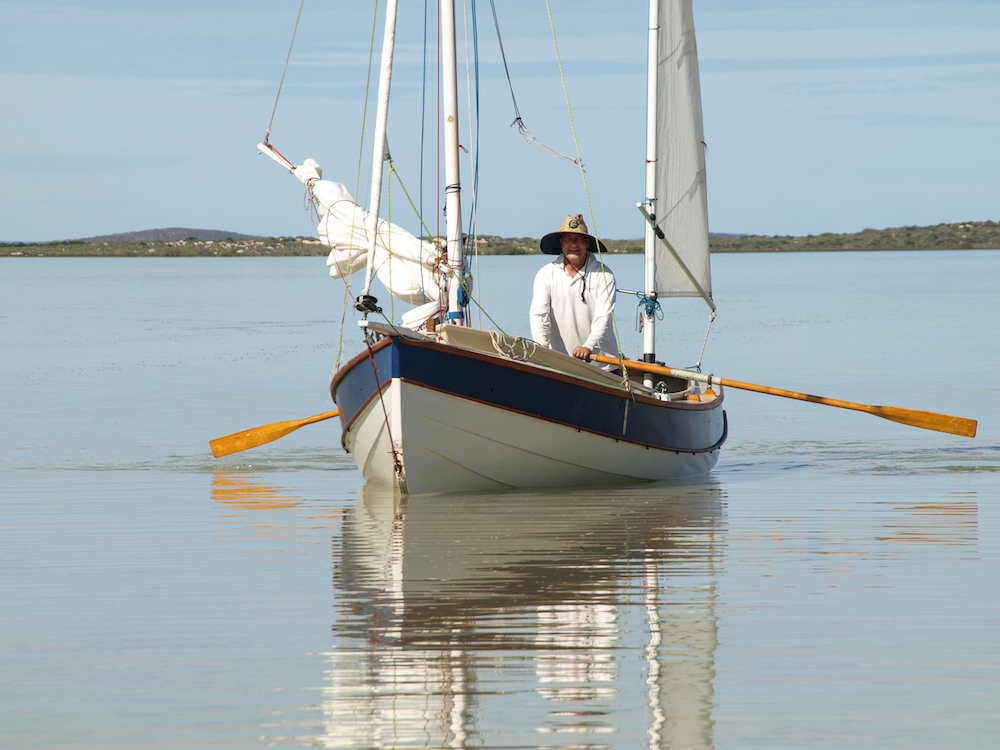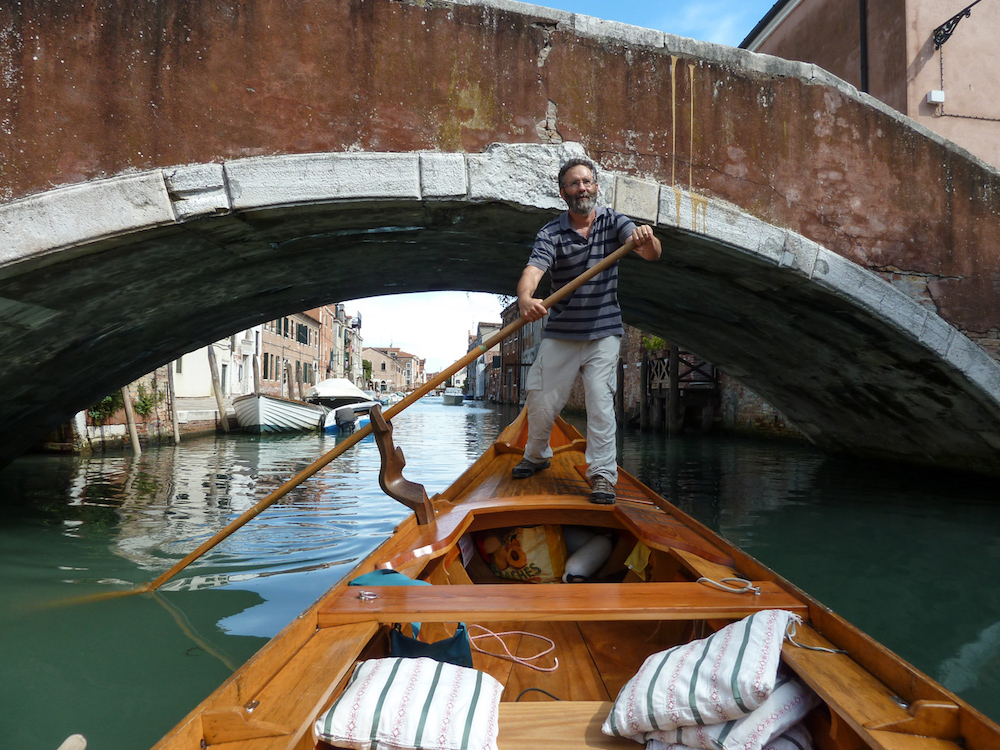Rowing Geometry for Fat Boats
I decided it would be good to set up my Welsford Navigator so that it could be rowed. What I wanted was an alternative to having to use an outboard to get in and out of a boat ramp jetty. I found it really annoying to be carrying around an outboard that was only being used to travel perhaps no more than 50m to get in and out of the dock.
So I fitted rowlocks, got myself some basic 8' oars and, sitting on my centrecase capping, off I went. Well, despite the far from optimal setup, and my poor technique, I was surprised how well the boat rowed and how much I enjoyed it.
After returning from a week of rowing a Drascombe Lugger in the rain during Sail Caledonia I decided I should attempt some kind of optimisation of my rowing setup.
If you go looking on the web you will find all sorts of rules of thumb and magic formulas for oar length, rowlock width, seat heights and so on. However, when I attempted to apply these to my boat some things came out decidedly odd and, in particular, the seat height recommendations were clearly wrong. Basically these rules of thumb and formulas are based around a classic fixed seat rowing boat of about 5m length with a beam of about 1.2m and freeboard of about 0.25 to 0.3m. If you have a boat significantly different from this the formulas will not work.
So I went back to basics to work things out from first principles for myself. It really is quite simple, there are just three things to consider.
- Seat position: Sitting on your rowing thwart you will find there is
a comfortable distance you can reach out to start the stroke and a corresponding
distance you can pull back to in order to finish the stroke. Roughly half way
between these two positions the oar should be pointing out at 90 degrees to the
boat. This sets the position of the rowlock relative to your seat.
- Seat height: When the oar blade is in the water the ideal is that you
want to be pulling the handle back at a height roughly level with a point about
50mm above your sternum. This is at the centre of your chest where you can feel
the end of your rib cage. This is the height that is suggested for rowing
shells. Given that we want to be able to row when there are at least small
waves we probably want the handle to come up to our chest a bit higher, say
100mm above your sternum. If the handle ends up much lower than this you will
not have enough room to push the handle down to keep your blade clear of the
water on the return stroke. If it is much higher than this you will find things
becoming awkward and uncomfortable. This dictates your desired seat
height.
- Gearing: The ratio of the oar length outside the rowlock to the length inside the rowlock sets the gearing. The gearing will typically be somewhere between 2 and 2.7. A value of 2 (as I currently have with my short 8' oars on my Navigator) is low and 2.7 will be high. For most of us the oar length will be whatever we already have, or what we can readily buy, and/or whatever we can readily stow in our boats. As long as this results in a gearing a bit better than 2 then things should be acceptable.
Working through the details for my Navigator:
Rowlock position behind the seat
My `Reaching Out' point is about 640mm from the back edge of the seat.
My `Reaching Back' point is roughly aligned with the back edge of the seat.
Placing the oarlock 320mm behind the back edge of the seat will put it half way between these points.
This fits in with the 10 to 13 inches that is commonly quoted for this distance
(and it is commonly quoted in inches!).
Seat height
I am 170cm tall. When sitting I find that a point that is 100mm above my sternum ends up being about 400mm above the seat. That's where I want the handles to be when the blades are in the water.
Probably the easiest and most practical approach is to place your oars in the rowlocks, dip your blades to the required depth in the water and measure the height of the handles and set your seat height accordingly. Alternately you can use a bit of simple geometry and calculate things as follows:
My rowlocks are 900mm from the centreline and about 420mm above the waterline. Assuming that I hold my 2400mm oars so that the handle ends are 800mm inboard from the rowlock this results in about 900mm of shaft between the rowlock and water when the blade is immersed (I am assuming 700mm of blade is immersed). By relative scaling of the similar triangles that are formed (marked in textured blue in the diagram below) one can determine that the handles will be about 373mm above the rowlocks. Given my target of having the handles about 400mm above the seat this would suggest that I should sit rather high - only about 25mm below the rowlocks. The diagram below shows the geometry for a 2400mm oar on the left and a 2750mm (9') oar on the right.

Note the appropriate seat height changes a fair bit with oar length. Using a 2750mm long oar, as shown on the right, I end up with about 1250mm of shaft between the rowlock and water. In this case the handle height will be about 270mm above the rowlocks. I would then want to be sitting about 130mm below the rowlocks (except my centreboard capping is only 70mm below the rowlocks...) Thus, in this case, changing the oar length by about 350mm changes the appropriate seat height by about 100mm.
This is all very well in theory, does it work? Well, sitting on a thin seat board attached to the top of my centreboard capping I am about 70mm below the rowlocks. This seems to work quite well with both my 2400mm oars and with a new set of 2750mm oars that I have recently made. The height seems really good with the 2400mm oars. With the 2750mm oars I can feel that I am a little bit high but it still works very well. Certainly the extra gearing I get with the longer oars is greatly appreciated. As an experiment with the 2400mm oars I did try sitting on a foam pad that raised my seating by 50mm. This made a big difference in a negative way. It was very hard to keep the handles low enough on the return stroke to keep the blades clear of the water, in fact rowing was very awkward. I imagine it would be impossible with the 2750mm oars.
Inevitably your ability to estimate your freeboard and the depth with which you immerse your blades etc will be approximate. Whatever seat height you calculate will need some tuning. Certainly I have found that a variation of 50mm in seat height can make a noticeable difference in the comfort of your rowing so it is worthwhile experimenting.
Gearing
With the 2400mm oars my gearing is 2 (800mm inboard and 1600mm outboard). This is low but acceptable (just). Using my new 2750mm oars the gearing improves to about 2.4 (800mm inboard and 1950mm outboard). This is very much nicer to row with.
It is interesting to note that racing sculls operate with a gearing lower than one might think at around 2.2 - 2.4. Even though they use oars around 2.9m long the inboard length of the oar is about 0.9m due to the wide outriggers, this brings the gearing down. The difference here is that, with a sliding seat, the speed at which the handle is pulled back is the speed of your arms plus the speed of your legs extending. There is no need for high gearing to get the blade to move rapidly.
Stand up rowing
The example calculations for my Navigator show that when you have a beamy boat with a high freeboard you can end up having a rowing position that is rather high in the boat. This can become impractical and an alternative that may be worth considering is to stand up and row facing forward, Venetian style. Paul Ricketts found this to be the most effective way to row his Welsford Pathfinder. I think it is a natural fit if you have a deep and beamy boat like a Pathfinder. If your boat is not deep then you will need to extend the rowlocks up to a height that is somewhere between your knees and hips. I have tried stand up rowing with my Navigator but it is not as deep as a Pathfinder and I found that I had to bend over excessively. If the oarlocks were raised about 200mm it would probably work well.

Paul Ricketts rowing in Shark Bay
Some links that I found useful
- Gaco Oarlocks A wonderful set of web pages on fixed seat rowing.
- Oar Cruising Blog Lots of useful material.
- John C. Harris' article in Wooden Boat Magazine on the geometry of rowing
- The Ergonomics of Rowing by Jim Flood. A very interesting on-line book on the ergonomics of sliding seat rowing by an Olympic rowing coach. (Unfortunately you have to sign up to Scibd for a free trial to read this.)
- A nice video tutorial on sliding seat rowing
- Venetian rowing
- Regata Voga La Scuola Skip to 4:00 to see a Venetian rowing race
